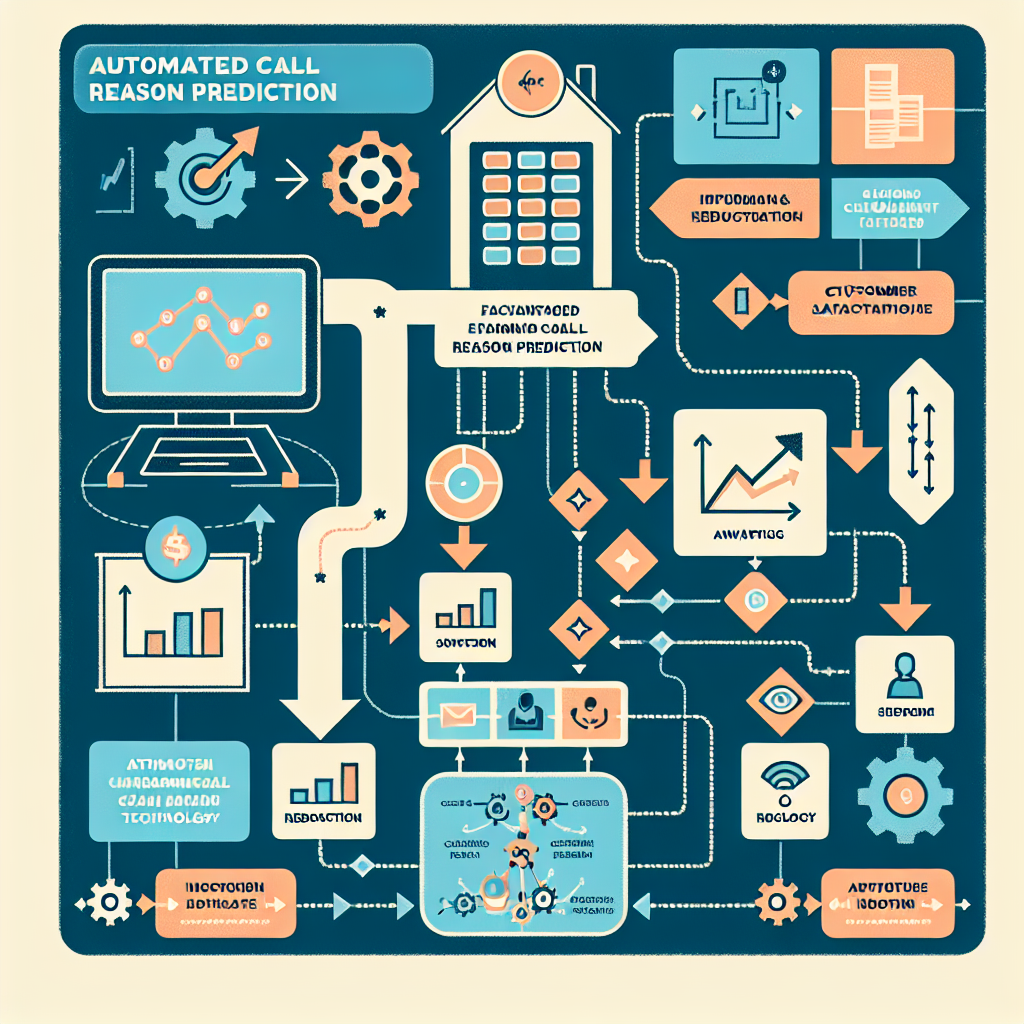
In the rapidly evolving field of customer service, one trend that has emerged on the front lines of innovative strategy is Automated Call Reason Prediction. This application of artificial intelligence (AI) aims to equip customer service representatives with vital information about a customer's call purpose before they pick up the phone. By providing agents with this advance knowledge, it enables them to prepare, improving efficiency, customer satisfaction, and ultimately, the company's bottom line.

But how does call reason prediction actually work? At its core, the technology uses historical call data and natural language processing (NLP) to predict why a customer is most likely calling. By analyzing word choice, speech patterns, and even sentiment, AI can make highly accurate predictions about the purpose of a given call. When correctly instituted, call reason prediction can arm agents with the relevant information they need to resolve concerns swiftly and capably.
There are even more advantages to using AI in this capacity. For instance, it can predict prospective customer behavior, assist in staff training by highlighting the most common call reasons, and help refine products or services based on gathered direct feedback.
For these reasons, companies around the globe are beginning to leverage automated call reason prediction, recognizing its potential to radically enhance their customer service operations. In the following sections, we will delve deeper into the mechanics of this technology, exploring exactly how it functions and why it could be the next big step in your company's evolution.
In the dynamic world of customer service, information is power. The more effectively service agents can anticipate customer needs, the better they can provide solutions. In this context, Artificial Intelligence (AI) has become a game-changing tool, empowering agents with the ability to predict the reason for a customer's call before they even pick up. This automated call reason prediction is revolutionalising customer interactions, resulting in more personalized and efficient service.
AI-enhanced customer service functions by processing live call data and historical information gathered from earlier interactions. Leveraging sophisticated algorithms, AI can analyze patterns and behavioural signals, thus predicting with high accuracy the core reason behind a call. This enables service agents to interact with customers efficiently, catering to specific issues right off the bat, and thus reducing resolution time.
Consider a recurrent scenario where a customer experiences issues with a software product a week after a new update. Based on historical data, AI predicts that the customer is calling to report a bug or ask for troubleshooting assistance for the new update. Equipped with this prognostic information, the service representative is immediately able to address the client's concerns, without necessitating preliminary queries. Hence, AI-facilitated predictive analysis not only saves time but also enhances the customer's overall experience.
Moreover, this method of preemptive problem-solving fosters better relationships between customers and the service provider. Customers appreciate the swift and precise response, thus building trust and loyalty. Meanwhile, for businesses, this translates into increased customer retention and positive word-of-mouth advertising.
In conclusion, automated call reason prediction is a powerful tool in the hands of customer service agents. As AI continues to improve, so too will the precision of this tool and its ability to foster positive customer interactions.
Check out IBM's insights into how AI is reshaping various industries, including customer service.
In the telemarketing industry, preparation is key to consistent productivity and success. A new and innovative approach that's gaining ground is the use of Automated Call Reason Prediction. This technology provides call agents with a preliminary idea of the customer’s reason for calling, before directly communicating with them. It paves the way for reduced handling time, improved customer satisfaction, and decreased stress levels for agents, among other substantial benefits.
Foremost, handling time is significantly reduced. Long call durations not only consume more resources, but they can also lead to customer frustration. By understanding the purpose of the call early on, agents can pre-plan their responses and ensure prompt, accurate assistance. This efficiency boosts the capacity of call centers to attend to more customer queries within the same time frame.

Additionally, customer relations greatly benefit from this approach. When agents are equipped with adequate, relevant information about customer issues, they can provide tailored service. This leads to higher customer satisfaction rates and fosters a positive image for the company. Through automation, companies can impart a customer-first mindset, proactively addressing concerns and providing precise solutions.
Lastly, we cannot overemphasize the importance of a lowered stress environment for call agents. In a role that commonly induces high levels of stress, providing agents with the right tools to execute their tasks efficiently can greatly reduce pressure and improve overall job satisfaction. The stress reduction, in turn, can lead to higher productivity and improved agent retention rates.
In essence, the Automated Call Reason Prediction is a revolutionary tool, driving efficiency and promoting a happier workforce environment in call centers. Adopting such a proactive approach signals a progressive and customer-oriented business ethos.
Customer relationship management (CRM) systems form the cornerstone of most businesses’ customer service strategies. As the conduit for customer interactions, these systems amass vast amounts of valuable data. To aid call centre agents in making the most of this data, the integration of Automated Call Reason Prediction systems is becoming increasingly relevant.
Automated Call Reason Prediction uses data mining techniques to anticipate the reason behind a customer's call before the conversation begins, as such, providing the agent with the relevant information they need to handle it efficiently. This can significantly reduce the waiting time for customers and improve their overall experience.
The process of integrating an automated call reason prediction system into an existing CRM system can be seamless with the correct procedures. The first step is to ensure the prediction system is compatible with your CRM software. An open API link or data connector could be used for this purpose. This integration route allows the two systems to communicate effectively, exchanging information in a secure and controlled manner.
When the prediction system is connected, the existing data in your CRM system can be used to train and refine the predictive model. Over time, the system will learn from the data and improve accuracy in predicting customer call reasons. It's crucial to ensure customer data is always properly anonymized and secured during this process to maintain customer privacy and meet data protection regulation requirements.
In conclusion, integrating an Automated Call Reason Prediction system with your CRM shouldn't disrupt current operations. Instead, it will enhance data utilization, leading to more informed agents, shortened response times, and ultimately, happier customers.
In a world where customer service has increasingly become a priority, businesses have turned to technological innovations to improve their outcomes. One such innovation is Automated Call Reason Prediction, a potent tool that enables customer service teams to anticipate the reasons for incoming calls and prepare with relevant information to address such issues effectively. Here are some real-world applications where this tool has made significant strides.

In the telecommunications sphere, a leading global brand implemented an Automated Call Reason Prediction model. Immediately, there was a 20% decline in call handling time, leading to increased customer satisfaction scores and improved efficiency among the call center agents.
The banking industry has equally reaped the rewards of this technology. A well-respected European bank integrated call reason prediction into its engagement strategy and reported a 15% boost in first contact resolution. This feat has led to a reduction in the number of repeat calls and a considerable decrease in operation costs.
The healthcare sector, an industry traditionally inundated with intricate call requests, transformed its operations with the help of call reason prediction models. One notable example is a prominent health service provider that reported improved service delivery to their patients, and key metrics like abandoned call rates dropped by 16%.
In conclusion, these case studies elucidate the increasing indispensability of Automated Call Reason Prediction in contemporary business operations. By integrating sophisticated predictive models with customer service protocols, organizations across multiple sectors are incredibly simplifying agent workflows and enhancing customer experiences.
As artificial intelligence (AI) continues to summon considerable interest in different industries, customer service is undoubtedly an area experiencing seismic changes. With Automated Call Reason Prediction, the customer-agent conversation has taken a smooth, predictive turn, enabling businesses to offer immediate and personalized customer assistance.
Notable for it's potential, Automated Call Reason Prediction is projected to experience considerable advancements in the near future. Here, we unveil some expert speculations about the future trends and predictions in this evolving field.
First and foremost, experts believe that personalization will dominate the frontlines in the AI-driven customer service sector. Services like Watson Assistant are investing into developing systems capable of understanding customer preferences and history, predicting the reasoning behind their calls and providing tailored responses. This level of personalization is predicted to boost customer satisfaction substantially.
Secondly, trends indicate a rise in the integration of Natural Language Processing (NLP) in Automated Call Reason Prediction. NLP will enable these systems to interpret the nuances of human language more efficiently, thus improving their prediction accuracy. Researches at Google are currently working towards this direction.
Lastly, experts forecast the incorporation of Real-time Analysis into prediction systems. This will arm customer service agents with up-to-the-second call predictions, further enhancing their preparedness and response times.
With these predicted technological advancements, the role of AI - represented by Automated Call Reason Prediction - in customer service is poised to hit unparalleled heights. The trends suggest a future where accurate call predictions and personalized customer interactions become the benchmark for outstanding customer service.
Start your free trial for My AI Front Desk today, it takes minutes to setup!








